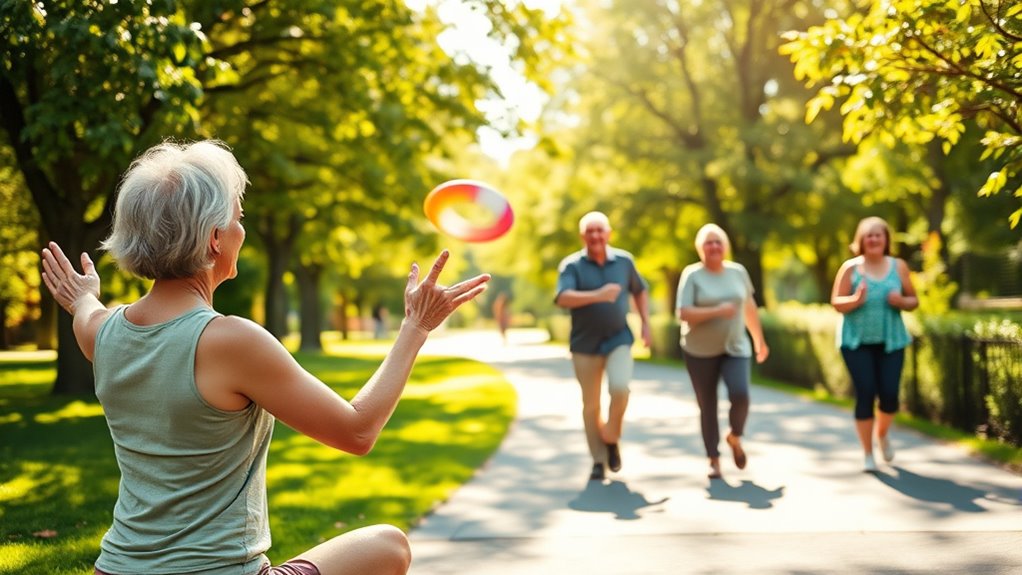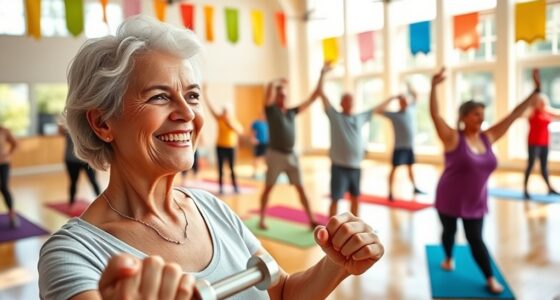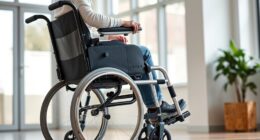To stay fit, seniors need a balanced exercise program. Aim for at least 150 minutes of moderate aerobic activity each week, including low-impact cardio like walking or water aerobics. Incorporate strength training twice a week, and focus on exercises for balance and flexibility, such as tai chi and stretching. Setting realistic goals and joining group classes can keep you motivated. Discover how to tailor these components for your specific needs and enhance your overall well-being.
Key Takeaways
- Aim for at least 150 minutes of moderate aerobic activity weekly, broken into manageable sessions of 10-15 minutes each.
- Incorporate strength training exercises, such as chair squats and wall push-ups, on two or more days each week.
- Include balance exercises like tai chi or yoga at least three times weekly to improve stability and reduce fall risk.
- Engage in flexibility exercises regularly to enhance mobility and alleviate discomfort from conditions like arthritis.
- Consult healthcare providers to create a tailored exercise plan that considers individual fitness levels and medical history.
Understanding the Importance of Exercise for Seniors

As you age, understanding the importance of exercise becomes essential for maintaining your overall health and well-being.
Regular exercise helps you maintain bone and muscle strength, reducing the risk of falls and injuries. Engaging in physical activity not only boosts your energy levels but also improves the quality of your sleep, lowering the risk of chronic diseases like heart disease and diabetes. Additionally, physical activity can aid in preventing fatigue and feeling energized throughout the day. Moreover, prioritizing a balanced diet alongside regular exercise can amplify the benefits for your health and wellness. Furthermore, creating transforming spaces in your living environment can make it easier and more enjoyable to stay active. Additionally, fostering emotional alignment through exercise can enhance your mental well-being and motivation.
Exercise enhances cognitive function, contributing to better brain health and a reduced risk of cognitive decline. Participating in group activities can also provide social interaction, which improves mental well-being and offers emotional support. Incorporating mindfulness practices into your fitness routine can further enhance your overall mental resilience.
Prioritizing fitness through regular exercise is key to enjoying a vibrant, active lifestyle as you age.
Recommended Weekly Exercise Guidelines

To maintain ideal health, older adults should aim for at least 150 minutes of moderate aerobic activity each week. You can break this down into manageable 10- or 15-minute sessions throughout the week. Additionally, newborn sleep patterns can inform seniors about the importance of establishing a consistent routine, which can also aid in maintaining overall health and wellness. Engaging in regular physical activity can also help meet dogs’ emotional needs and provide companionship, which is beneficial for seniors. Regular exercise has been shown to improve overall health and can help seniors manage chronic conditions more effectively. Moreover, incorporating personalized learning pathways can help seniors adapt their exercise programs to better suit their individual capabilities and preferences.
In addition to aerobic exercise, it’s essential to include strength training for seniors on two or more days to preserve muscle mass and bone health. Don’t forget to incorporate balance exercises, like tai chi or yoga, at least three times a week. These exercises help prevent falls and enhance stability.
If you’re up for more intensity, the CDC suggests 75 minutes of vigorous aerobic activity weekly as an alternative. Tailor your exercise program to fit your abilities and health conditions for the best results. Additionally, consider how financial planning for assisted living can impact your overall wellness and ability to stay active.
Key Components of a Balanced Exercise Program

Creating a balanced exercise program for seniors isn’t just about getting active; it’s about incorporating a mix of activities that enhance overall health and well-being. Aim for at least 150 minutes of moderate aerobic activity weekly, along with strength training two days a week. Additionally, regular stress management techniques can help seniors maintain motivation and reduce anxiety related to physical activity. It’s also important to consider the role of natural remedies to support overall health during exercise. Engaging in regular physical activity can also help alleviate feelings of isolation, similar to how texting humor fosters connections among seniors. Moreover, incorporating daily exercise requirements tailored to personal fitness levels can optimize health benefits and improve quality of life. Don’t forget to include balance exercises and flexibility work to boost mobility and minimize fall risks. Additionally, being aware of common symptoms can help seniors recognize health issues early.
Here’s a simple breakdown:
| Component | Frequency |
|---|---|
| Aerobic Activity | 150 minutes/week |
| Strength Training | 2 days/week |
| Balance Exercises | 2-3 times/week |
| Flexibility Exercises | Regularly |
| Low-Impact Activities | As preferred |
Safe Strength Training Exercises for Seniors

Strength training is essential for seniors, not only because it builds muscle but also because it enhances independence and mobility. It’s important to understand that individual responses vary to different types of exercise, so finding what works best for you is key. Incorporating low carb high protein breakfast ideas can also provide the necessary energy and nutrients to support your fitness routine. Additionally, engaging in regular exercise can attract pollinators like bees and butterflies that contribute to a healthier environment. It is vital to consider emotional regulation during your exercise routine as it can improve focus and overall well-being.
Strength training is vital for seniors, promoting muscle growth, independence, and improved mobility.
Here are some safe strength training exercises for seniors that can help improve balance and maintain strength:
- Chair Squats: Stand up and sit down from a chair to strengthen your legs.
- Wall Push-Ups: Press against a wall to build upper body strength without straining.
- Resistance Band Workouts: Use bands to add resistance while being gentle on your joints.
- Seated Dumbbell Press: Sit and lift dumbbells overhead to improve arm strength.
Aim for strength training two or more days a week. Incorporating mindfulness practices during your workouts can help enhance focus and reduce anxiety. Start with light weights or bodyweight exercises, focusing on proper form to prevent injuries.
Incorporating Low-Impact Cardio Activities
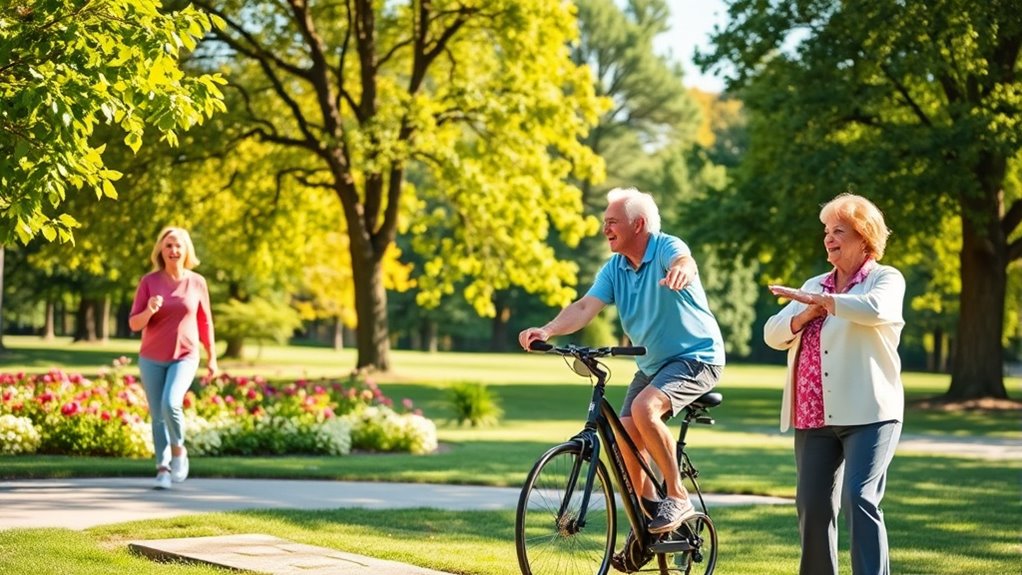
Building on the benefits of strength training, incorporating low-impact cardio activities into your routine can further enhance your fitness and well-being. Engaging in at least 150 minutes of moderate-intensity low-impact cardio each week can boost your heart health, energy levels, and decrease the risk of chronic diseases.
Consider joining water aerobics classes, like SilverSneakers Splash, for a fun way to exercise with support. Cycling, whether on stationary bikes or scenic trails, strengthens your legs and improves cardiovascular health without stressing your joints.
Additionally, incorporating short walking sessions throughout the day can greatly improve your mobility and overall fitness. Aim for 10,000 steps daily to lower your mortality risk by 46% over ten years, keeping you active and healthy. Seasonal variations in your outdoor activities can also provide a refreshing change and motivate you to stay active throughout the year.
Essential Balance and Mobility Exercises

As you age, incorporating essential balance and mobility exercises into your routine becomes important for maintaining independence and preventing falls.
These exercises greatly improve stability, coordination, and flexibility, which are essential for fall prevention. Aim to practice balance and mobility activities at least three times a week.
Here are some effective exercises to take into account:
- Tai Chi – Enhances balance and promotes relaxation.
- Single-leg stands – Strengthens legs and improves coordination.
- Neck stretches – Maintains flexibility in your upper body.
- Ankle circles and hip rotations – Support mobility and range of motion.
Regularly engaging in these exercises boosts confidence, reduces anxiety about falling, and promotes safe movement, ultimately enhancing your quality of life.
Benefits of Stretching and Flexibility

Maintaining balance and mobility is essential for seniors, and stretching plays a key role in that. By incorporating stretching exercises into your routine, you can enhance flexibility, which improves your range of motion in joints. This is critical for maintaining independence in daily activities.
Regular stretching reduces muscle tension and boosts circulation, leading to better mobility and a lower risk of injury. Flexibility training also helps improve balance and coordination, which are crucial for fall prevention.
Additionally, daily stretching can alleviate discomfort from conditions like arthritis and lower back pain, enhancing your quality of life. Engaging in these exercises promotes relaxation and reduces stress levels, supporting both your physical and mental well-being.
Tips for Staying Motivated and Consistent

Staying motivated and consistent with your exercise routine can feel challenging, especially when life gets busy. Here are some tips to help you stay on track:
- Set realistic fitness goals: Aim for at least 150 minutes of moderate aerobic activity weekly to boost your health and longevity.
- Join a group exercise class: Engaging in social activities enhances motivational accountability and makes your workouts more enjoyable.
- Incorporate variety: Mix different types of exercises to keep things fresh and fun, preventing boredom.
- Keep a fitness journal: Track your progress to celebrate improvements, which can give you a sense of accomplishment and encourage continued effort.
Resources for Seniors to Access Exercise Programs
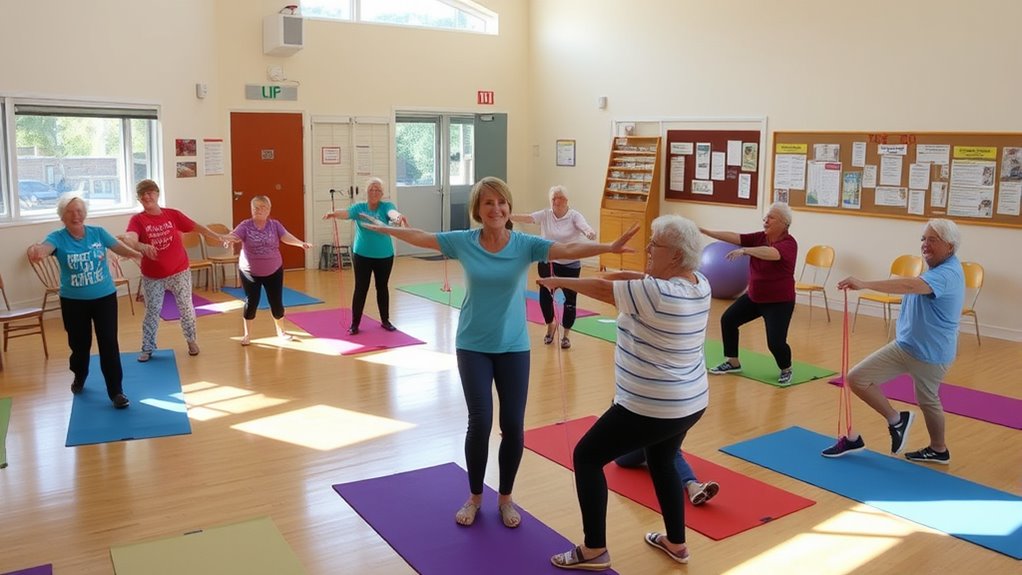
Numerous resources are available to help seniors access exercise programs that cater to their unique needs. Organizations like the National Council on Aging (NCOA) connect you to community fitness initiatives designed specifically for older adults.
You can also explore the SilverSneakers program, which offers free online fitness resources, including on-demand workout videos and live classes tailored for seniors. Additionally, evidence-based programs like EnhanceFitness and Fit and Strong! focus on flexibility, strength, and aerobic activities to boost your health.
Local community centers often host group fitness classes, providing social interaction and motivation while ensuring safety.
Consulting With Healthcare Providers for Tailored Plans
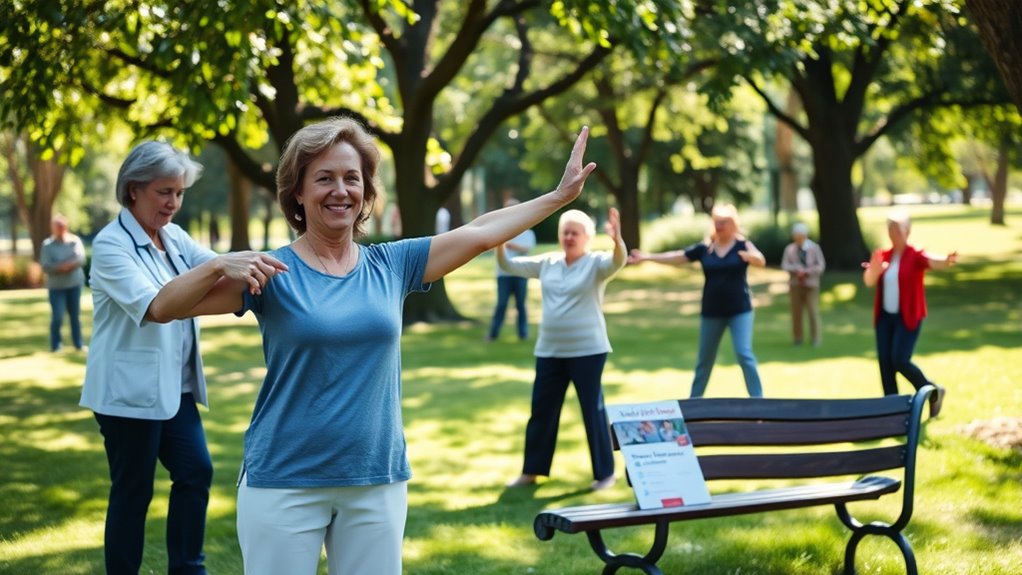
When it comes to crafting a safe and effective exercise plan, consulting with your healthcare provider is essential. They’ll assess your health status and help you develop tailored plans that suit your needs.
Here are four key benefits of engaging with healthcare providers:
- Personalized Recommendations: Get exercise suggestions based on your medical history.
- Addressing Chronic Conditions: Discuss any existing issues like arthritis or heart disease for safe exercise options.
- Regular Check-ins: Adjust your program as your health or fitness levels change.
- Goal Setting: Work collaboratively to set realistic fitness goals that enhance your well-being.
Frequently Asked Questions
What Is the Number One Exercise for Seniors?
The number one exercise for seniors is walking. It’s a low-impact activity that you can easily fit into your daily routine.
Regular walking not only boosts your cardiovascular health but also greatly lowers your mortality risk. Plus, it enhances your mental well-being by alleviating symptoms of depression and anxiety.
Aim for about 10,000 steps a day to reap the maximum benefits and maintain your mobility. You’ll find it adaptable to your individual fitness level.
What Is the Best Workout Program for Seniors?
To create the best workout program for seniors, you should aim for at least 150 minutes of moderate-intensity aerobic activity each week.
Add two or more days of muscle-strengthening exercises, like bodyweight workouts or resistance bands.
Don’t forget to include balance exercises, such as tai chi.
Finally, incorporate flexibility and mobility routines to enhance your range of motion.
Always consult your healthcare provider to tailor your program to your unique needs and abilities.
What Is the Number 1 Exercise to Increase Balance in Seniors?
If you’re looking to enhance your balance, Tai Chi is the number one exercise you should try.
Its slow, controlled movements help improve stability and coordination, making it effective for reducing the risk of falls by nearly 47%.
You’ll not only boost your physical strength but also experience mental benefits, like reduced stress and improved focus.
Consider joining a local class or finding an online session to get started and enjoy these incredible benefits.
What Exercise Burns the Most Belly Fat for Seniors?
Did you know that incorporating just 150 minutes of moderate exercise each week can greatly impact your belly fat?
For seniors, low-impact aerobic exercises like walking or swimming are great options. They’re easy on your joints while effectively burning calories.
Adding strength training with resistance bands boosts your metabolism, helping reduce abdominal fat.
Don’t forget to mix in some balance exercises like tai chi to enhance your overall fitness and well-being!
Conclusion
You’ve learned about the perfect exercise program for seniors, but what happens when you take that first step? Imagine feeling stronger, more energized, and ready to tackle each day with vigor. As you incorporate these exercises into your routine, you might just surprise yourself with how much you can achieve. So, are you ready to access a healthier, more active lifestyle? Don’t wait—your journey to fitness and liveliness starts now!
